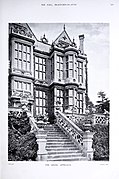The Hall, Bradford-on-Avon
Coordinates: 51°20′49″N 2°14′50″W / 51.3469°N 2.24734°W

The Hall, at times known as Kingston House and The Duke's House, is a Grade I listed Jacobean mansion in Bradford-on-Avon, Wiltshire, England.
The Hall was built around 1610 for John Hall, a wealthy mill owner, and is at the east end of the town.[1][2][3] The Hall family of Bradford can be traced back to at least the 13th century, under the name of "De Aulâ" or "De la Sale" (salle being french for hall). John Hall's grandson, also named John Hall, had no legitimate children and left his estate to his great-niece Rachel Baynton. She later married William Pierrepont, who became Duke of Kingston-upon-Hull, giving the house its alternate names. After the second Duke died without issue, the house was sold to Thomas Divett, in 1802, who established a woollen mill, and sublet the house, which fell into disrepair. In 1848, the house was sold to Stephen Moulton, who undertook major restorations. During the restoration, many old documents were discovered, which were catalogued by Canon J.E.Jackson.[4] The house has remained in the Moulton family, and is now managed by the Alex Moulton Charitable Trust.[5]
The Hall, in particular the south front, is notable for having "more glass than wall".[1] Not all contemporaries approved of the style. Francis Bacon, in On Building refers to "fair houses so full of glass that one cannot tell where to become to be out of the sun or cold".[6][7] The architect is not known. Similarities of style to Longleat, not far away and built about 30 years earlier, have led to suggestions that Robert Smythson may have been involved in the design.[7] The building sits high on a terrace. The south front has three projecting bays of two stories, with gables above. The outer two bays are wider than the central one, and have semi-circular projections. Open rings above the bays form a kind of balustrade. The terrace has a balustrade with a central staircase, leading to the main doorway of the house, which has a round arch, flanking Tuscan columns, and scroll-work above. Inside, the rooms are high, and there are a number of Jacobean chimney-pieces and moulded plaster ceilings. The gardens have an octagonal dovecot and two temples.[1][2][3][7][8]

View of The Hall, by C.J. Richardson, published in 1837, so before the restoration in 1850[9]

Drawing of chimney-piece and doorway by Richardson[9]

Engraving of the Hall, 1854[4]

The stairway to the terrace, phographed by Charles Latham in the late 1890s[10]
The Hall has been highly regarded from its early days to the present. John Aubrey (1670) described it as "the best built house for the quality of a gentleman in Wiltshire".[4] W. J. Loftie in 1893 called it the most perfect of the smaller houses in the "second Elizabethan" style. [11] The house was selected as the model for the pavilion which was built for the 1900 Exhibition in Paris.[10][12]
The house was designated as Grade I listed in 1954.[13] Pevsner and Cherry (1975) refer to it as of national importance.[2]
References[]
- ^ a b c Oswald, Arthur (1962). "The Hall, Bradford-on-Avon - I". Country Life. 132 (3423): 840–844. ISSN 0045-8856.
- ^ a b c Pevsner, Nikolaus; Cherry, Bridget (1975). The Buildings of England: Wiltshire (2 ed.). Harmondsworth: Penguin. pp. 135–136. ISBN 0140710264.
- ^ a b Gomme, Andor Harvey; Maguire, Alison (2008). Design and Plan in the Country House: From Castle Donjons to Palladian Boxes. Yale University Press. pp. 207–208. ISBN 978-0-300-12645-7.
- ^ a b c Jackson, J.E. (1854). "Kingston House, Bradford". Wiltshire Archaeology and Natural History Magazine. 1: 265–302.
- ^ "The Hall, Bradford on Avon". Alex Moulton Charitable Trust. Retrieved 3 December 2021.
- ^ Bacon, Francis (1909). Essays, civil and moral. New York: P.F. Collier and Son. pp. 114–117.
- ^ a b c Oswald, Arthur (1962). "The Hall, Bradford-on-Avon - II". Country Life. 132 (3424): 900–904. ISSN 0045-8856.
- ^ Oswald, Arthur (1962). "The Hall, Bradford-on-Avon - III". Country Life. 132 (3425): 1020–1023. ISSN 0045-8856.
- ^ a b Richardson, Charles James (1837). Observations on the Architecture of England During the Reigns of Queen Elizabeth and King James I. &c. &c. J. Weale. OCLC 1008320177.
- ^ a b Tipping, H.A. (1900). Gardens, old and new; the country house & its garden environment. Volume 1. London: Country Life. pp. 211–214.
- ^ Loftie, William John (1893). Inigo Jones and Wren: Or, The Rise and Decline of Modern Architecture in England. Rivington, Percival & Company. OCLC 1000939204.
- ^ Allwood, John (1977). The Great Exhibitions. Studio Vista. p. 99. ISBN 978-0-289-70792-0.
- ^ Historic England. "The Hall, Holt Road (1200529)". National Heritage List for England. Retrieved 4 December 2021.
External links[]
| Wikimedia Commons has media related to The Hall, Bradford-on-Avon. |
- The Hall, Bradford on Avon at freshford.com
- Country houses in Wiltshire
- Grade I listed buildings in Wiltshire
- Buildings and structures completed in the 1600s
- Bradford-on-Avon




